More on AMD’s XConnect Tech: Thunderbolt 3 for External Radeons
by Ryan Smith on March 10, 2016 9:00 AM EST- Posted in
- GPUs
- AMD
- Intel
- Radeon
- Thunderbolt
- Thunderbolt 3
- eGFX

Last night AMD issued a driver update that brought support for a new technology, XConnect. In a nutshell, XConnect is AMD’s trade name for running external video cards via Thunderbolt 3, a long awaited development that Thunderbolt owner Intel is finally getting behind and allowing. AMD’s driver release notes offered a handful of details, and now the official embargo for the tech is lifting, so we can fill in some of the blanks.
As our more observant readers may recall, when Intel unveiled Thunderbolt 3 back in June, they announced that they would finally be approving external video cards via Thunderbolt, and that they would be partnering with AMD to develop the initial implementation. More recently, at CES 2016 Razer unveiled the Razer Blade Stealth ultrabook, which was being immediately promoted as supporting external video cards, and was being shown off with its accompanying full power Core external video card chassis. Add the two up, and you can guess where this is going.
Today then is the formal launch of AMD’s Thunderbolt 3 video card efforts, which they are branding XConnect. The first drivers for XConnect were released last night, and now AMD is qualifying the Blade Stealth as the first laptop ready for XConnect. That said, it should be noted that while the Blade Stealth has been shipping for some time, Razer’s accompanying Core chassis has yet to ship, so anyone looking to try out XConnect will need to wait to get their hands on a Core.
Along with today’s formal unveiling of the technology, AMD is also laying out the technical requirements for supporting XConnect. Not just any laptop/desktop with Thunderbolt 3 can support an external GPU, as there are specific hardware and software requirements, which is why the Blade Stealth is the first qualified laptop. In particular, laptops need to support what is being called the Thunderbolt 3 external graphics standard, or eGFX for short. The eGFX standard in turn requires that vendors implement the necessary extensions for external graphics into their BIOS, including functionality necessary to support plug ‘n play operation. Also required is v.16 (or later) of the Thunderbolt firmware, Windows 10, and an active (not passive) Thunderbolt cable for bandwidth reasons.
With all of the necessary parts in play, from a technical perspective what we’re looking at is a somewhat more complex AMD Enduro switchable graphics setup, except with an external GPU. XConnect allows for an external video card to feed either a laptop’s internal display via the normal switchable graphics protocols, or an external monitor hooked up to the external video card. I dare say that much of this is mundane in 2016 as switchable graphics have been with us for some number of years now. What is novel here, as Intel told us as far back as June, is that what really changed their tune was that there is finally a sensible GPU hotplugging solution in place, allowing video cards to be added and removed without rebooting. This makes it much easier to use an eGFX solution – hence AMD’s focus on plug ‘n play functionality – and it means the operating system won’t crash and burn if an external video card is removed. Though from AMD’s whitepaper it’s clear that applications using the external GPU will likely crash, which is why external video cards still should be ejected for best results.
On the software side then AMD has gone ahead and implemented just this. The XConnect functionality in the latest Radeon drivers includes a system tray icon that that tells the user what applications are running on an external GPU, and can force close them if necessary to allow the GPU to be ejected/removed.
On the hardware side of matters, AMD is treating this as a high-end solution, and given the costs involved in Thunderbolt 3 I expect this will be the case universally. The company has qualified most of their high end graphics cards, including the R9 280, R9 290 series (sans 295X2), the R9 300 series, R9 Nano, and R9 Fury, while Fury X is excluded since its radiator won’t work with the Razer Core. Also supported are the mobile derivatives of these GPUs – for use in lower-power “graphics dock” devices – and future Polaris dGPUs will be supported as well. Overall from the GPU perspective Thunderbolt is just a higher latency PCIe 3.0 x4 connection, so it affords a lot of compatibility.
| XConnect GPU Compatibility List | ||
| Radeon R9 Fury | ||
| Radeon R9 Nano | ||
| Radeon R9 300 Series | ||
| Radeon R9 290 & 290X | ||
| Radeon R9 280 | ||
| Mobile dGPUs Based on the Above | ||
| Planned: Polaris dGPUs | ||
Meanwhile from a performance perspective AMD isn’t publishing specific numbers on how an external video card performs relative to an internal one, but PCIe 3.0 x4 testing is easy enough to do. With only one-quarter the bandwidth of a full PCIe 3.0 x16 slot Thunderbolt 3 will be constraining at times, but various benchmarks have put the average performance hit for a high-end card at under 10%. That of course will vary from game to game, as games that push a lot of data to the GPU or games that frequently interact with the GPU (e.g. retrieving physics simulation results) will be more greatly impacted by the reduced bandwidth and higher latency than simpler, more straightforward games.
From a broader perspective, the launch of Razer’s Blade Stealth laptop and Core chassis are part of what AMD hopes will be a much larger ecosystem for eGFX-capable laptops and enclosures. While each end needs to be certified, the fact that the transport layer is standardized Thunderbolt 3 means that any chassis should work with any laptop, and future solutions need not be a matching setup ala the Blade Stealth + Core. To that end Thunderbolt eGFX is not the first external graphics solution, but as a standard it has the potential to be more widespread than previous proprietary solutions such as MSI’s Shadow expansion dock or AMD’s own previous XGP initiative, not to mention it’s not tied to any one GPU vendor.
The catch, I suspect, will be getting laptop vendors to include Thunderbolt 3 support, as historically Thunderbolt has seen little traction outside of Apple laptops. The switch from the mini-Displayport connector to the USB Type-C connector is likely to help some with that, but a big consideration will be the space and power requirements of Intel’s Alpine Ridge controller, along with the costs of buying and integrating it.
As for the eGFX chassis, the Razer Core is a solid example of what to expect with high-end designs, which is a Thunderbolt dock on steroids. Along with providing enough power and space for a double-wide 375W video card, it also contains a Gigabit Ethernet port hanging off of the Thunderbolt controller’s PCIe lanes, USB 3.0 ports that are (presumably) coming off of the Alpine Ridge controller itself, and the ability to charge the Blade Stealth laptop. Back at IDF Intel was also pitching the idea for a smaller “graphics dock” concept, which would have a lower-power mobile-class dGPU integrated into a docking device that provided similar I/O functionality, to allow for a cheaper all-in-one device that provided a more modest boost to graphics performance.
Overall, gaming has been one of the few bright spots in an otherwise sluggish PC industry, and that goes for both gaming desktops and gaming laptops. For AMD and Intel, the launch of Thunderbolt eGFX/XConnect in turn allows them to further expand the gaming laptop market, moving beyond desktop replacement class laptops and more limited 15” laptops by offering desktop-class GPU performance to any laptop that incorporates a Thunderbolt 3 port and the necessary BIOS support. At the same time Ultrabooks themselves have been a steady and well received market, though making poor gaming devices due to a lack of space for a dGPU – never mind something that offers desktop-like performance. So after earlier efforts to pair them up with external graphics with any luck this will be the start of a viable gaming Ultrabook market as well.



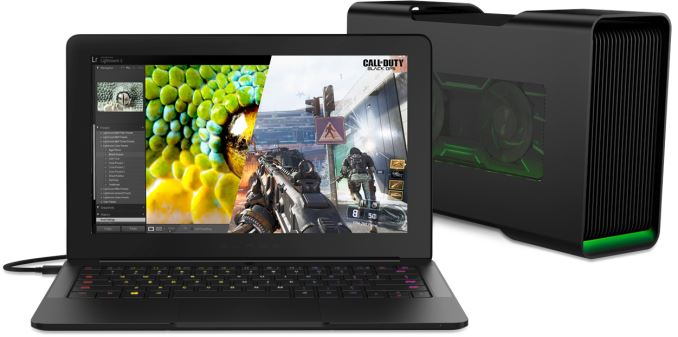
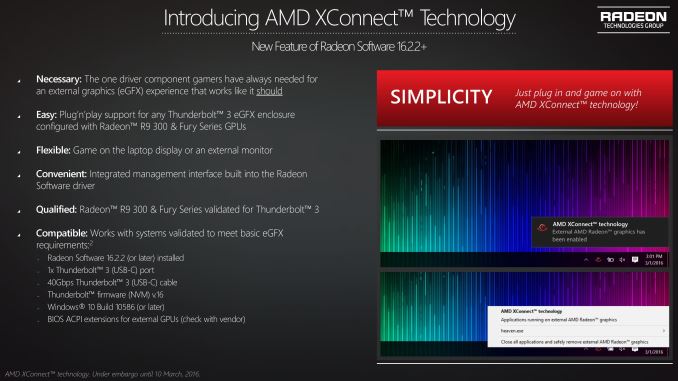
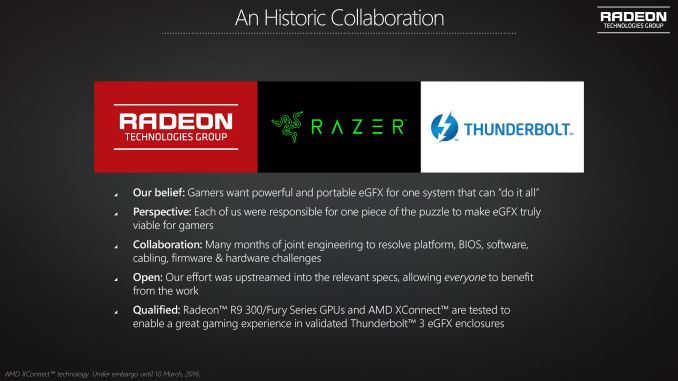
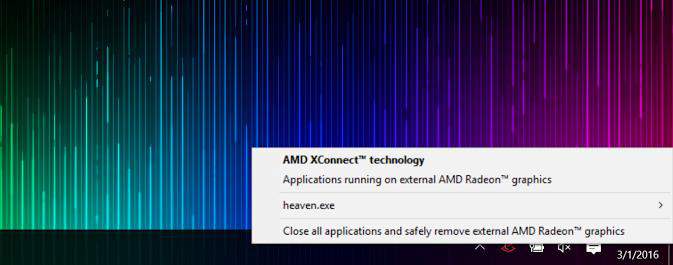

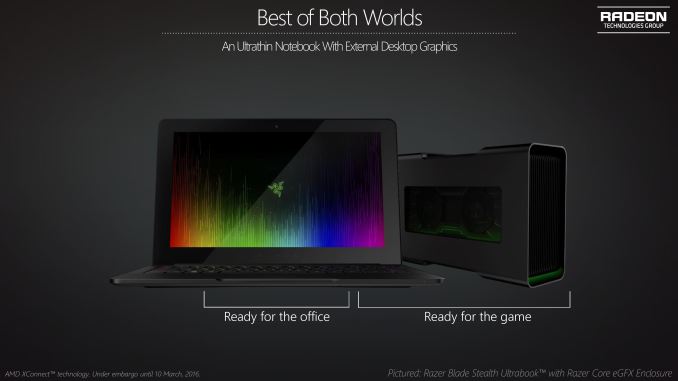














64 Comments
View All Comments
Murloc - Thursday, March 10, 2016 - link
well if ultrabooks tend to be GPU-bottlenecked when gaming as of now (I'm not sure how much), it's still an improvement, at least when it comes to the cheaper docks with a dGPU inside, not the razer core with a top desktop part of course.DanNeely - Thursday, March 10, 2016 - link
Maybe we'll see an uptick in the use of Intel's dual core 28W mobile parts. Adjust the TDP down to the more common 17W baseline on battery to extend lifetime per charge; but when plugged into the wall let them open up again so they're running at about the same clockspeed as the 45W mobile chips. They'd still be somewhat limited in only having 2 physical cores; but with significant chunks of gaming code still being single thread performance dependent this would go a large way to narrowing the gap.rhysiam - Thursday, March 10, 2016 - link
And while we're at it, why not build an external GPU box that also incorporates additional cooling for the laptop to enable those higher CPU TDPs without excessive noise? Truly effective solutions would probably have to be proprietary I suppose, I'm not sure how effective those laptop coolers which just blow air on the chassis actually are... I'm guesing not very effective?Back to to the main topic though, I sure hope these solutions are more stable and receive better long-term support than previous iterations of switch able graphics, particularly from AMD.
Oxford Guy - Friday, March 11, 2016 - link
Or get rid of the stupid obsession over thinness.Light weight? Yes. Thin? Why?
guidryp - Thursday, March 10, 2016 - link
I wonder if we will ever see Mac Support for this. GPU is one of the biggest weaknesses in Macs.jsntech - Thursday, March 10, 2016 - link
It seems such support would need to come from Apple. As awesome as that would be (and it would be reeeeeeally awesome), I'm having a hard time imagining Apple getting behind it. We can hope.tipoo - Thursday, March 10, 2016 - link
Under Boot Camp it may work, some people got external graphics to work on TB2. Under OSX, probably not, but for a gaming external GPU you want Windows anyways to not lose 30% of your performance to the 5 year old OpenGL version in OSXmdriftmeyer - Thursday, March 10, 2016 - link
Apple could add OpenGL 4.5 support in a few months, if they wanted to do so. They focused on bringing Metal API to both iOS and OS X. Time will tell. But with all the work Game Engine devs have done with Apple on Metal API for iOS the vast bulk of that work will just transfer over to OS X.mdriftmeyer - Thursday, March 10, 2016 - link
It just needs a kext and how Apple's Metal API would leverage the GCN hardware is up to them.sovking - Thursday, March 10, 2016 - link
Why such solution should be limited to laptops ?Let's think about people using desktops for work and casual gamers can use moder cpu having graphics integrated (or APU), without the need of discrete graphics, saving power during the long work-day. At the evening they want to play to some recent game with hight details: they plug their desktop to eGPU, which have the horsepower needed. Next day they continue to use their desktop without their eGPU.
In this way they can use smaller case, that produce less heat and less noise.
For many desktop users could be nice and useful to plug and play with eGPU ;-)